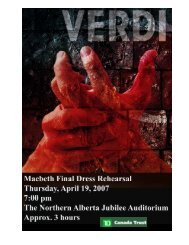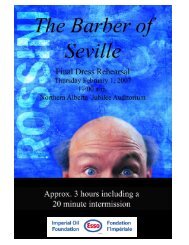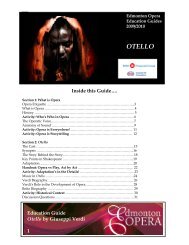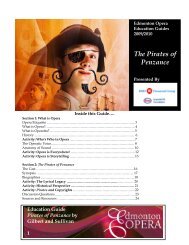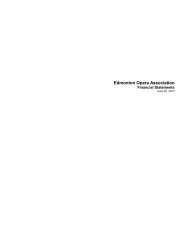Education Guide The Flying Dutchman by ... - Edmonton Opera
Education Guide The Flying Dutchman by ... - Edmonton Opera
Education Guide The Flying Dutchman by ... - Edmonton Opera
Create successful ePaper yourself
Turn your PDF publications into a flip-book with our unique Google optimized e-Paper software.
Activity: Teacher Resource<br />
Background: Leitmotif and the Composers Who Love <strong>The</strong>m<br />
Long before the signature entrances of Indiana Jones, Jaws, and Darth Vader, there was<br />
music that reminded audiences of a particular character, emotion, or theme. Short,<br />
recurring motifs (from the French “motive” and translating as “short theme”) in<br />
orchestral music began appearing in the 1700’s, although not in any extensive or<br />
systematic way. Although these musical statements were usually short melodies, they<br />
could be particular chord progressions or as simple as particular repeated rhythms.<br />
Composers Carl Maria von Weber and Beethoven, among others, used this technique<br />
(think of the opening movement in Beethoven’s fifth symphony – Beethoven’s<br />
biographer suggested that the motif represents “fate knocking at the door.”)<br />
<strong>The</strong> idea of a musical statement representing a particular feeling or theme was also used<br />
<strong>by</strong> Hector Berlioz in his Symphonie Fantastique, wherein the recurring motif represents<br />
the love of the central characters, even though there are no singers on stage<br />
representing those lovers. Berlioz called this idea the idée fixe.<br />
While this idea had been around for a number of years before Richard Wagner arrived<br />
on the scene, it is he who is most often associated with the term leitmotif (loosely<br />
translated meaning “leading motif”). He used leitmotif extensively in his music,<br />
especially his operas and it is from this usage that they have become so intrinsically<br />
linked to his name. He used them to represent characters, ideas, thoughts and feelings<br />
in his work, and in his longest work, Der Ring des Nibelungen (or the Ring Cycle), there<br />
are dozens of motifs!<br />
Since Wagner, many other composers have used this technique in their works: Sergei<br />
Prokofiev uses it in Peter and the Wolf, Verdi gave his title character one in Aida, and<br />
stirred audiences with the music threatening the entrance of the “bad guy” Scarpia in<br />
Tosca. Today, leitmotifs appear constantly in movies and plays, and the term is even<br />
used in literary studies!<br />
While Wagner never named his leitmotifs, one of his students went to the trouble of<br />
identifying in some of his works all the motifs and naming each one after its idea or<br />
them, such as the “fate motif.” <strong>The</strong>re are several important leitmotifs in the <strong>Flying</strong><br />
<strong>Dutchman</strong>, and we have reproduced some of them on the following page.<br />
<strong>Education</strong> <strong>Guide</strong><br />
<strong>The</strong> <strong>Flying</strong> <strong>Dutchman</strong><br />
<strong>by</strong> Richard Wagner<br />
25



